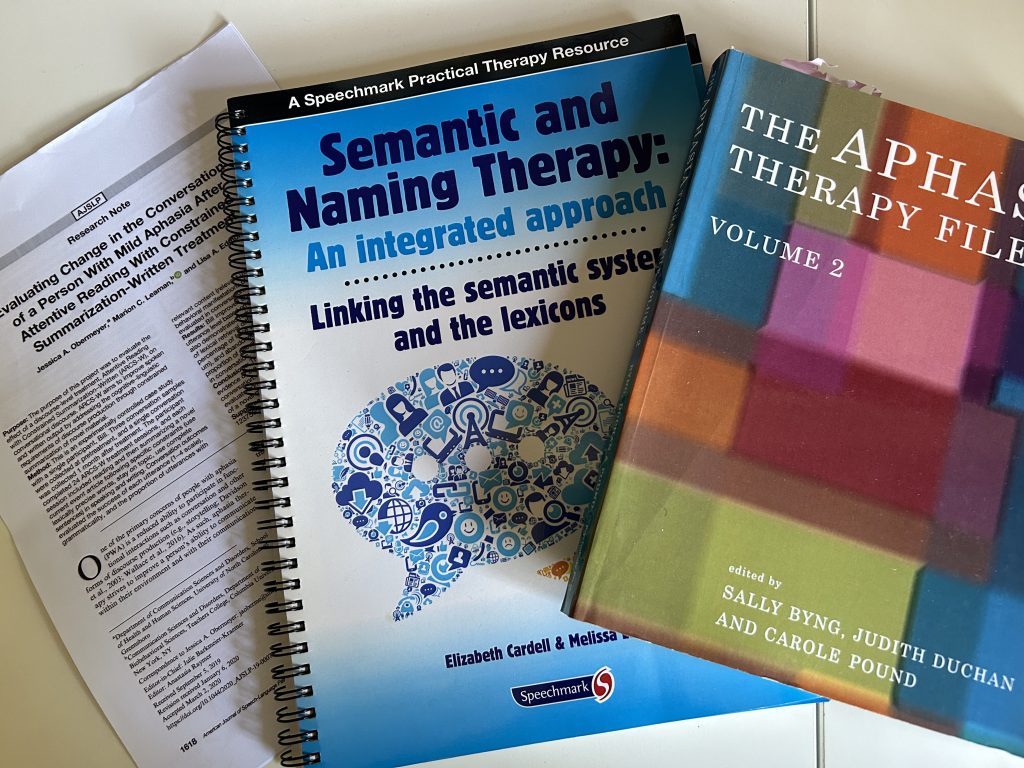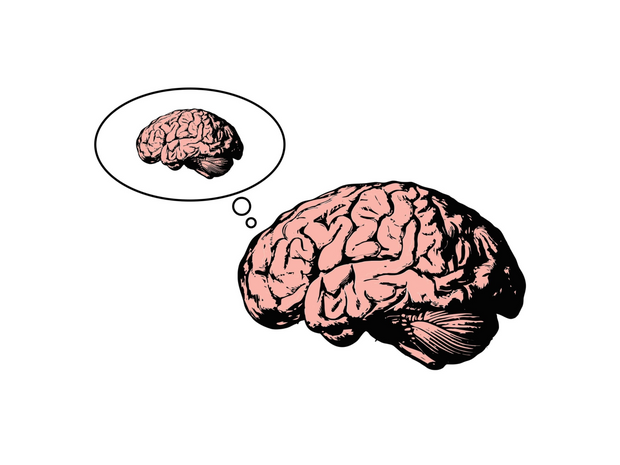Aphasia is relatively uncommon after Traumatic Brain Injury (TBI), with incidence estimated between 2-32%. In May 2024, I presented a poster at the Australasian Society for the Study of Brain Impairment (ASSBI) conference. This article provides supplementary materials to that poster.
Scroll to the bottom of this post for references and to find a downloadable copy of the poster as a PDF.
Breakdown of assessment and therapy tasks
Assessment
- PALPA 8 (non-word repetition), 35 (spelling-sound regularity reading), 53 (picture naming – written and verbal), 54 (picture naming x frequency)
- Word fluency (FAS, countries, things that can be closed)
- Discourse (TBI Bank protocol)
- Conversational discourse (words per minute, mazes, false starts, abandoned utterances, Bond & Godfrey Conversation Impression Scales)
- La Trobe Communication Questionnaire
- Cognitive-communication assessment (MCLA, Mt Wilga idioms)
- Participation / Quality of Life measures (SPRS-2, QOLIBRI)
Therapy – general principles
- Treatment materials relevant to the individual and their goals and interests
- Metacognitive and metalinguistic approach
- Goal Attainment Scaling
- Individual and group therapy
- Intensity varied from 3 times a week to once a week (with a therapy break of a few months early one, due to NDIS funding issues)
- Regular contact with family via Slack, email and phone contact with therapy team, and annual case conferences
Therapy – cognitive communication
- Reading comprehension (based on Watter et al 2020)
- Practicing auditory comprehension amid distraction
- Creating a template to structure a daily digital journal
- Practicing referring to the journal within conversation, as a memory aid
- Proactively reconnecting with old school friends, as an opportunity to practice conversation skills
- Analysis of “casual” and “formal” tone of speech
- Analysis of literal and hidden meaning in figurative language
Therapy – anomia
- Repetition naming therapy, errorless approach
- Naming therapy online (medium &hard sets)
- Attentive Reading with Constrained Summarisation – Written
- Advanced Naming therapy app
- Advanced word finding workbook (definitions, deductions, antonyms, synonyms)
- Phonological word finding activities (unscrambling)
- Sentence level = range of connectives
- Discourse level = synonym maps following WFD and retelling narratives using synonyms
- Numbers therapy app
Examples of assessment and therapy materials
Sample of therapy resources used

Sample of conversational discourse
Here is a 3-minute excerpt of conversation which demonstrates the combined impact of anomic aphasia and cognitive-communication difficulties after brain injury. Notice how well the client (male) is supported by their conversation partner (female).
Outcomes
Results
Quantitative outcomes can be seen within conversational discourse. Improvements were most evident in mazes (11 –> 4), reflecting fewer pauses, dysfluencies, repetitions and/or revisions within conversation, indicating a reduction in word finding difficulty.
Improvements were also seen in word fluency (FAS 6 –> 12), though after two years of treatment these remain in the severely impaired range.
Conversation analysis
Conclusion
Assessment at a single word level was necessary to diagnose impairments in phonological output lexicon. Assessment at a discourse level was necessary to identify the functional impact of anomia as well as tracking functional therapy outcomes. Word-level anomia treatments were combined with functional, discourse-level treatments to address both aphasia and cognitive-communication impairment. It was challenging to identify treatments and outcome measures that would achieve real-life communication benefits for this high-performing young man, who is determined to maximise recovery.
Summary
Thoughtful assessment and client-focused goal setting can result in positive communication outcomes for a young person with aphasia post-TBI. Improved word retrieval skills enables him to have more efficient and effective conversations, to better reflect his personality and intellect.
References
- Lucy Dipper, Jane Marshall, Mary Boyle, Nicola Botting, Deborah Hersh, Madeleine Pritchard & Madeline Cruice (2021) Treatment for improving discourse in aphasia: a systematic review and synthesis of the evidence base, Aphasiology, 35:9, 1125-1167, DOI: 10.1080/02687038.2020.1765305
- Julie Hickin, Beejal Mehta & Lucy Dipper (2015) To the sentence and beyond: a single case therapy report for mild aphasia, Aphasiology, 29:9, 1038-1061, DOI: 10.1080/02687038.2015.101047
- Sarah Fox , Elizabeth Armstrong & Larry Boles (2009) Conversational treatment in mild aphasia: A case study, Aphasiology, 23:7-8, 951-964, DOI: 10.1080/0268703080266952
- Richard Peach & Patrick Wong (2004) Integrating the message level into treatment for agrammatism using story retelling, Aphasiology, 18:5-7, 429-441, DOI: 10.1080/0268703044400014
- Nicholas, L. E., & Brookshire, R. H. (1993). A system for quantifying the informativeness and efficiency of the connected speech of adults with aphasia. Journal of Speech and Hearing Research, 36(2), 338-350.
- Obermeyer, J. A., Leaman, M. C., & Edmonds, L. A. (2020). Evaluating change in the conversation of a person with mild aphasia after attentive reading with constrained summarization-written treatment. American Journal of Speech-Language Pathology, 29(3), 1618-1628. https://doi.org/10.1044/2020_AJSLP-19-00078
- Obermeyer, J. A., & Edmonds, L. A. (2018). Attentive reading with constrained summarization adapted to address written discourse in people with mild aphasia. American Journal of Speech-Language Pathology, 27(1S), 392-405. https://doi.org/10.1044/2017_AJSLP-16-0200
- DeDe, G., & Hoover, E. (2021). Measuring change at the discourse-level following conversation treatment: Examples from mild and severe aphasia. Topics in Language Disorders, 41(1), 5-26. https://doi.org/10.1097/TLD.0000000000000243
- Lyndsey Nickels, Wendy Best, Britta Biedermann, Ruth Fink, Julie Hickin, David Howard, & Stacie Raymer (2002). Therapy for naming disorders: Revisiting, revising, and reviewing. APHASIOLOGY. 16. 935-979. 10.1080/02687030244000563.
- Weill-Chounlamountry A, Capelle N, Tessier C, Pradat-Diehl P (2013). Multimodal therapy of word retrieval disorder due to phonological encoding dysfunction. Brain Injury, 27(5), 620-31. doi: 10.3109/02699052.2013.767936. Epub 2013 Mar 8. PMID: 23473082.



